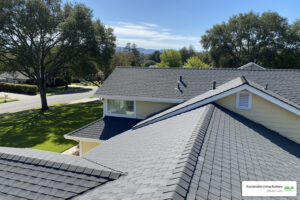
Flat vs. Sloped Roofs: Which Is the Best Choice for Rainy Weather
When it comes to roofing options, every type of roof comes with its perks and downsides depending on the roof’s design. Whether it’s a flat or sloped roof, there are multiple factors to consider when evaluating their performance in rainy weather. That is why we want to share with you everything you need to know to face the critical decision every home or business owner has to make: flat or sloped.
Flat Roofs: Modern and Open to Possibilities
Flat roofs are a common choice for business owners as they’re more commonly seen on commercial buildings; however, they’re also often part of contemporary homes. Despite what common sense might suggest, flat roofs are not perfectly level; instead, they are built with a slight slope to ensure proper water flow.
Advantages During Rainy Weather
- Easily Maintained: Flat roofs are easier to inspect and maintain compared to flat roofs, as their design allows to easily identify granule loss, leak sources, cracks, and other issues.
- Cost-Effective Installation: Flat roofs are generally less expensive than sloped roofs, requiring fewer materials and faster installation. At Sustainable Living Builders, we install modified bitumen and TPO flat roofs that are weather-resistant, prevent degradation, and withstand heavy loads.
- Multiuse Space: Flat roofs can be used as rooftop gardens, patios, or platforms for solar panels, enhancing energy production and lowering electricity costs.
Disadvantages During Rainy Weather
- Water Pooling: Even if flat roofs have a high slope built into them, they’re more prone to ponding water, which can lead to leaks or structural damage if not addressed. Ensuring proper water flow may require additional expenses, as most roofing companies work with the existing grading of a roof.
- Drainage Challenges: Flat roofs need to rely on advanced drainage systems like gutters, downspouts, or internal drains to ensure proper water flow and lower the risk of overflow or water pooling.
- Shorter Lifespan: Depending on material choice, durability, and treatment, flat roofs usually have a shorter lifespan than sloped roofs. However, their lifespan typically ranges from 20 to 30 years, depending on maintenance and climate conditions.
Sloped Roofs: Tradition That Endures
Sloped roofs have an angled pitch that facilitates water flow to a drainage system and away from the property. Often seen in residential buildings, they’re an excellent choice to enhance curb appeal due to the variety of materials that can be installed, such as shingles, metal, and other options that not only protect a house from rain but also boost its aesthetic.
Advantages During Rainy Weather
- Efficient Water Flow: The angled design of sloped roofs minimizes the risk of standing water and leaks by directing rain to components such as gutters, downspouts, or rain chains.
- Durability: Sloped roofs accommodate modern roofing systems capable of withstanding heavy rain, strong winds, algae, UV rays, and fire. They come in a wide variety of color choices and can even integrate solar panels to produce their own energy. They also have a longer lifespan when compared to flat roofs, ranging from 20 to 50 years, depending on the material choice, maintenance, and weather conditions.
- Low Maintenance: When properly installed, sloped roofs require minimal maintenance compared to flat roofs during rainy weather. However, it is important to keep an eye on the performance of your roofing system to prevent water intrusion.
Disadvantages During Rainy Weather
- Higher Installation Costs: The complex installation process of sloped roofs requires more time and labor, making them more expensive to install.
- Difficult Repairs: Repairing sloped roofs, especially those with steep pitches, can be more difficult and costly. Emergency repairs during the rainy season may take more time to be completed, and call for temporary solutions such as tarping.
- Less Usable Space: Sloped roofs do not provide the same opportunities for repurposing space for other uses, such as solar panel installation.
Both flat and sloped roofs can be effective in rainy weather, but the right choice depends on your specific needs, budget, and location. While sloped roofs offer better water runoff and durability, flat roofs provide a modern aesthetic and functional versatility.
LET US HELP YOU DECIDE!
At Sustainable Living Builders, Inc. we not only share roofing articles with you, we have a team of experts who are here to help you clear any doubts and face any decision regarding your roof’s needs. Contact us today for personalized recommendations and professional installation services tailored to your property and climate.








